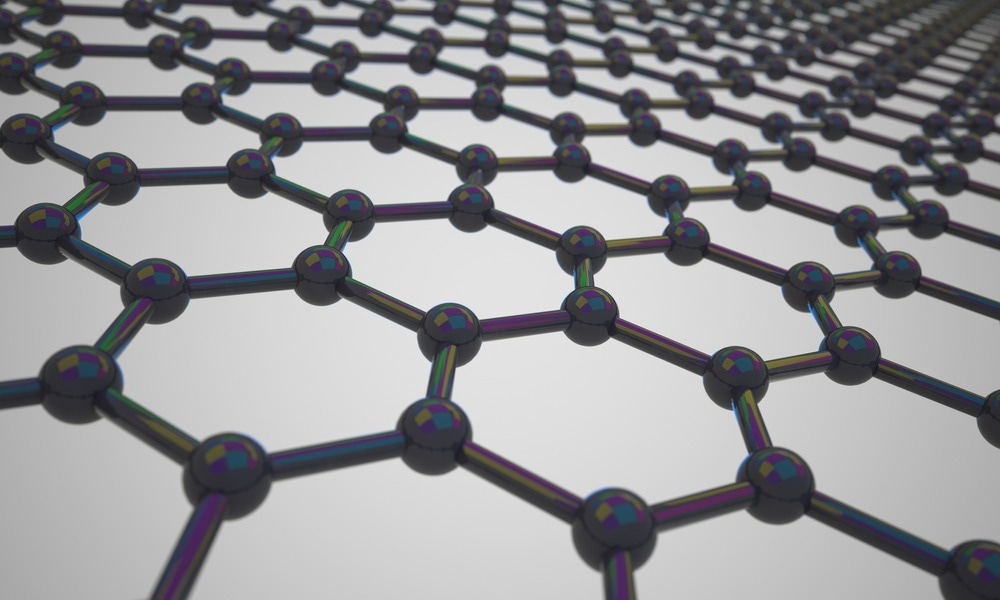Printing stretchable and skin-compatible conductors with low gauge factor and high durability is challenging. An article published in the journal Chemistry of Materials presented a skin-compatible graphene nanoplatelet (GNP)-based colloidal ink utilizing thermoplastic polyurethane (TPU) binder with tunable rheology to prepare graphene conductors with exceptional properties.

Study: Printed Stretchable Graphene Conductors for Wearable Technology. Image Credit: Artbox/Shutterstock.com
Besides their high conductivity even under 100% strain, graphene conductors demonstrated high fatigue resistance to cyclic strains of 20–50%. These graphene conductors showed a low sheet resistance of 34 ohms per square on heating at 120 degrees Celsius.
Moreover, photonic annealing at several energy levels decreased the sheet resistance to less than 10 ohms per square. However, the fatigue resistance and stretchability of the graphene conductors were preserved and could be tuned. Thus, stretchability, high conductivity, and cyclic stability combined with scalable ink production with adjustable rheology demonstrated a scope for high-volume manufacturing of stretchable wearables.
Graphene Conductors in Wearable Devices
The conductive components in printed electronics are based on metals. However, suitable metals are scarce or are prone to electromigration. Although metals like silver (Ag), gold (Au), and copper (Cu) are ideal for printed electronics, they are either expensive (Ag/Au) or toxic and highly susceptible to oxidation (Cu).
Flexible conductive polymers are alternatives to metals that could be integrated into wearable conductors. However, their stability issues hinder their practical applications. Carbon allotrope graphene is another alternative that is mechanically strong, environmentally inert, abundant, and highly conductive.
Graphene, a one-atom-thick layer of carbon atoms, is transparent, conducting, bendable, and yet one of the strongest known materials. However, the use of graphene as a conductor remains a great challenge because the lowest values of its sheet resistance demonstrated so far are above the values of commercially available indium tin oxide (ITO) (i.e. 10 ohms per square at an optical transmittance of 85%).
The GNPs are produced in a large-scale and cost-effective manner which facilitates the easy production of GNP-based inks, an alternative to metal-based ink for wearable technology. Various industrial printing approaches demand inks with different physical properties, including surface tension, rheology, and drying time.
Despite the efficiency of inkjet printing in achieving high-resolution deposition, it requires ink of low viscosity (i.e., low concentration), which limits the printed track’s conductivity. Contrastingly, screen-printing, and flexographic technologies are flexible, simple, fast, and scalable methods to produce wearable electronics. Screen-printing prints thick layers and can accommodate a broad range of inks and substrates.
Printed Stretchable Graphene Conductors Based on GNP Ink
Previously, graphene-based strain sensors were manufactured via screen printing, and stretchable supercapacitors were printed using a conductive polymeric binder-based ink with a small amount of graphene.
The printed stretchable sweat sensors developed by Park, H et al. used GNP-based ink composed of TPU in N-methyl-2-pyrrolidone (NMP), and cotton fabrics were decorated with the developed ink to produce strain sensors. However, these inks lacked adjustable rheology, limiting their conductivity and stretchability over many cycles.
Thus, an ideal conductive track for wearable electronic applications was expected to have high conductivity, high stretchability, high cyclic stability, and low gauge factor. In the present study, a GNP-based ink was developed that met all these requirements for screen printing stretchable, durable, and skin-compatible graphene conductors.
The developed graphene conductors had a sheet resistance as low as 34 ohms per square on TPU substrates after drying at 120 degrees Celsius. This was further reduced to less than 10 ohms per square via photonic annealing while retaining its stretchability, demonstrating the potential of photonic annealing in modulating the sheet resistance of GNP-based stretchable graphene conductors.
The current approach allowed scalable production of GNPs on flexible substrates using skin compatible TPU binder system, facilitating adjustable rheology. The GNP-based ink resulted in straight graphene conductors that were conductive even at 100% strain.
These graphene conductors demonstrated a low gauge factor and minimal fatigue with cyclic strain for up to 1000 cycles at 20−50% strain. Thus, compared to silver or gold conductors, the graphene conductors were resistant to fatigue and had a low gauge factor.
Conclusion
In summary, the TPU- and GNP-based ink was formulated and utilized for screen printing nontoxic stretchable graphene conductors on various flexible and stretchable substrates with 200 micrometers feature sizes.
The sheet resistance of stretchable tracks was as low as 34 ohms per square on TPU and remained conductive even at 100% strain. Thus, printed graphene conductors were subjected to strain cycles of 20% and 50% peak strain. In contrast to silver or gold conductors, the graphene conductors were highly resistant to fatigue and exhibited low gauge factors.
Modulating the sheet resistance of graphene conductors by photonic annealing significantly reduced the sheet resistance while retaining the tuning drift and stretchability. Thus, the scalability and flexibility in formulating the ink and postprocessing paved a new path for the industrial production of stretchable and flexible graphene conductors for applications in wearable electronics.
Reference
Hazendonk, L.S.V et al. (2022) Printed Stretchable Graphene Conductors for Wearable Technology. Chemistry of Materials. https://pubs.acs.org/doi/10.1021/acs.chemmater.2c02007
Disclaimer: The views expressed here are those of the author expressed in their private capacity and do not necessarily represent the views of AZoM.com Limited T/A AZoNetwork the owner and operator of this website. This disclaimer forms part of the Terms and conditions of use of this website.